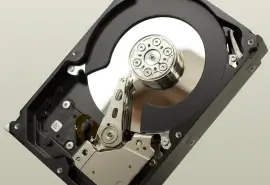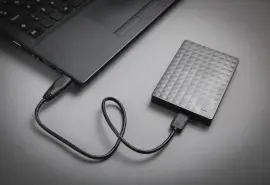Disposing old or unused hard disk drives (HDDs) has never been more essential. Researchers at Cybersecurity Ventures project the global annual cost of cybercrime to reach $8 trillion in 2023. One of the easiest paths to accessing confidential files comes from acquiring old hard drives that have not been properly destroyed.
Importance of Data Destruction
Instructions for how to dispose of hard drives are often inaccurate or inadequate. As a result, public knowledge of the practice does not match its importance. Consider these two inescapable realities when using hard drives:
First, hard drives store a significant amount of sensitive information.
And all hard drives are destined for failure or replacement.
For hard drive failure, users can build full backups or contact a certified data recovery service to retrieve irreplaceable files. But most users do not have destruction or disposal strategies after replacing damaged or obsolete hard drives.
To protect personal data past the hard drive’s lifespan, people should assess their specific needs, then proceed with the appropriate method.
Whether a hard drive’s usage is personal or professional, it contains valuable, private data. If the hard drive falls into the wrong hands, there could be enormous consequences and costs. The hard drive’s data could include information like bank accounts, credit cards, social security numbers, log-in credentials, or intellectual property.
Erasing data does not ensure its complete removal from the hard drive. Through various programs and techniques, malicious actors can restore deleted data, leaving individuals and organizations at an increased risk for identity theft and other cybercrimes. These entities must invest time or resources into reliable hard drive destruction to avoid potential data breaches.
Secure Data Recovery, the authority in RAID, SSD, and hard drive recovery since 2007, acquires old hard drives in various conditions to facilitate hard drive repair services. We source unused models for part replacement. In a sample of fourteen hard drives that were either proclaimed dead or listed strictly for parts, we found that only one seller had properly sanitized their device. The remaining 93% had not. Our data recovery engineers successfully retrieved all of the original data from seven out of fourteen devices. Five of the seven did not even require extensive repairs.
Across those seven hard drives, we recovered 187,630 pictures, 3,325 videos, 19,223 documents, 5,931 audio files, and 4 mailbox databases. Secure Data Recovery spent just $98.82 to procure all fourteen hard drives. That’s an average of $7.06 per device.

For such a small sum, any potential cybercriminal could collect your intellectual property or personally identifiable information from the discarded drive. With that kind of data, someone could inflict irreparable damage.
Do not allow unauthorized parties to access compromising information on old computers, hard drives, or storage devices.
Proper data destruction procedures are invaluable.
It could be the difference between a data breach and data protection.
6 Methods for Destroying Old Hard Drives
Different data destruction methods offer different degrees of protection. Some might be limited but convenient. Others might be comprehensive but expensive. Determining the ideal approach depends on the unique situation. As a general rule, users storing more sensitive data should prioritize the most effective methods, given the rising threat of cybercrime. Professionals should sanitize hard drives containing classified documents, financial statements, or medical records.
Despite concerns over its costs, data security is cheaper than recovering from a devastating attack or mishandling incident.
Relinquishing possession of data can be stressful, so vetting destruction companies is vital. Check their certifications. Confirm their controls. If unconvinced, inquire about on-site destruction.
All companies should issue a certificate of destruction upon completion.
(Note: Perform a backup before beginning the data destruction process. A cloud service, external hard drive, or other storage device can preserve critical data on the old hard drive.)
Method 1 - Shredding
Hard drive shredding is an effective and popular form of destruction. To shred, technicians run computer hard drives through a media shredder. The industrial shredder tears the drive’s platters into small, irregular pieces. The data is impossible for third parties to obtain once shreds are all that remain. Even motivated criminals cannot extract its contents or reassemble the pieces into a functioning device with available commercial methods.
Method 2 - Disintegrating
Disintegrating is an enterprise-level option. Similar to shredding, disintegrating leaves the hard drive unrecognizable. But, instead of cutting the platters, disintegrating reduces hard drives to a fine residue. In that state, the best tools in the world could not recover a trace of data from the device. Though more expensive and time-consuming, organizations with large amounts of sensitive information often choose disintegration.
Method 3 - Degaussing
Degaussing is one of the most efficient methods of hard drive destruction. A degausser is a machine or wand that disrupts the drive’s platters and prevents continued operation. The degausser generates a powerful magnetic force to achieve destruction, scrambling the hard drive’s magnetic field. Once demagnetized, the hard drive is unreadable and unusable.
Method 4 - Melting
Another viable data destruction option is melting. Melting is the process of dipping the entire hard drive in harmful acids. The combination of chemicals corrodes mechanical components and strips the film from the platter. Despite its effectiveness, melting is the most dangerous method. The acids and toxic fumes can burn the user’s skin, irritate their breathing, and ruin the environment. For these reasons, experts do not recommend melting to destroy an old hard drive.
Method 5 - Drilling
Drilling is a common choice for individuals or organizations on a budget. With a drill or drill press and protective equipment, users can puncture the hard drive case and damage its internal components, including the platters. There is no need to disassemble the device. For best results, punch through the drive’s platters in a random pattern. Afterward, the hard drive will not operate. While drilling is not as effective as the methods listed above, it is a sufficient deterrent for most actors.
Method 6 - Overwriting
Overwriting saved data is another step users can take themselves. Through full formatting of the hard drive or running a data erasure program like DBAN, users can clear the contents of their device. When entrusting a program to wipe data, confirm that it adheres to the Department of Defense’s three-pass method. While the standard might seem redundant, it provides greater data security. Overwriting also allows for the reuse of hardware. However, since the hard drive is not physically destroyed in the process, there is a hypothetical risk that sophisticated parties could recover its data with unknown or undiscovered techniques.
Misconceptions and Mistakes
When it comes to data destruction, there is little margin for error. Individuals and organizations must establish that their sensitive data is secure pre-destruction and post-disposal. The financial and reputational costs of a data breach are immense.
Still, too often, users listen to poor advice, overestimate their abilities, or underestimate the threats.
A few of the most prevalent proposals are ineffective.
Several websites suggest that users disassemble the device with a Torx screwdriver and scratch the drive’s platters with a flathead screwdriver. Others encourage users to smash the hard drive with a hammer. Some outlets report that submerging the media in water ruins its data.
These methods confuse severe damage for destruction.
With enough resources and time, experienced engineers can salvage the situation and recover portions of data from the device. Users who adopt these methods to protect confidential information are exposed to fraud.
In addition, mistakes made while sanitizing hard drives can leave recoverable data for cybercriminals. Even the most reliable methods, such as shredding or degaussing, require tools and training to execute. A non-industrial shredder will not scrap the drive. A refrigerator magnet will not demagnetize the device. A quick format will not erase all of its contents.
The list of possible errors goes on. And each jeopardizes the user.
Individuals and organizations should consider a credible destruction service. As cybercriminals become more proficient, the demand for secure disposal has increased.
In that regard, a professional is best equipped to purge compromising data from a hard drive before disposal.
Hard Drive Disposal
Once hard drive destruction is finished, hard drive disposal can begin.
Given the growing problem of electronic waste (e-waste), disposing of end-of-life devices is more urgent than ever. To reduce the amount of e-waste in landfills, IT asset disposition companies collect the byproducts of destroyed hard drives, then melt them at a processing plant. At that point, operators recycle the residue into an alloy.
Disposal does not just limit the environmental impact of e-waste. It further ensures that personal data remains private.
How To Wipe SSDs and Smartphones
Sanitization for flash storage differs from electromechanical storage.
Proven methods, such as shredding and degaussing, are ineffective for SSDs. Since SSDs store information in cells on small chips, even industrial shredders cannot guarantee the destruction of each structure. For shredding to succeed with an SSD, the shred width must be less than half of an inch, excluding most machines. Degaussing also does nothing to eradicate data because SSDs are based around integrated circuits.
If specialized shredding is not an option, users will have to utilize the overwriting method. However, the SSD’s resilient design still presents challenges. When writing new data, SSDs reorganize existing information. That means blocks of data could persist even after reallocation. And third parties could theoretically retrieve that valuable data.
Manufacturers of SSDs acknowledged these vulnerabilities and began offering built-in safeguards and utilities. Most modern SSDs feature hardware encryption to impede unauthorized access. For those worried about cybercriminals attempting to decrypt the device, prominent manufacturers developed software that resets the SSD’s blocks.
If interested in erasure utilities, confirm the model and review the manufacturer’s website for further instructions:
- Samsung SSD Magician
- Western Digital Dashboard
- Crucial Storage Executive
- Kingston SSD Manager
- Seagate SeaTools
Deleted data from iPhones and other smartphones tend to be more permanent and unrecoverable. Even restoration often requires access to the device and its passcode or password. Still, experts recommend destruction companies that can shred smartphones to secure their contents.
Conclusion
Data destruction is no longer optional. The threats are too great to ignore.
Individuals and organizations should assess their risks and address their shortcomings.
Failing to implement proven sanitization procedures could cause irreparable harm.
Concerned parties sometimes select multiple disposal methods to deter malicious actors.
At Secure Data Recovery, we are aware of the extraordinary advancements in our industry. The invention of state-of-the-art techniques and tools has made once-complicated recoveries routine. But more cybercriminals have access to the same equipment and knowledge.
Our data destruction services grant peace of mind to our customers. We know how to recover data from damaged or defective storage devices. And we know how to destroy data on the HDD or SSD, so no one else can recover it.
Contact us at 800-388-1266 for a free media disposal consultation.
You cannot afford a data breach.








